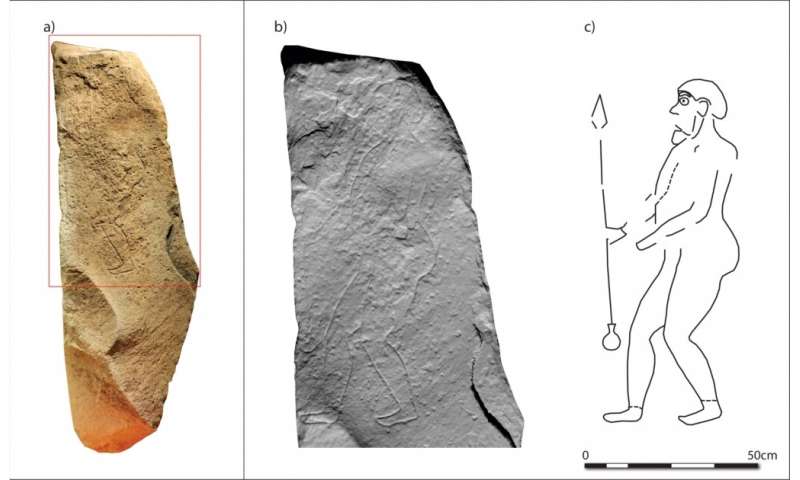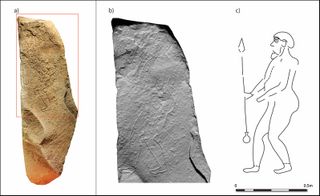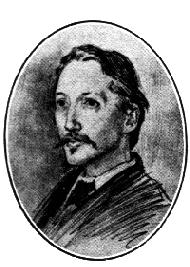Perth Pictish find offers glimpse into Scotland's warrior past

Archaeologists have carefully recreated images of a figure on a Pictish stone, discovered during the construction of a road in 2017, with the details uncovered offering new insights into Scotland's warrior past.
During ground clearance work close to Perth's McDiarmid Park, a nearly two meters-high monolith was found, depicting a male figure carrying a spear.
Though the outline of the man could be seen, the carving was faint in places and the surface of the stone had partly delaminated.
Archaeologists from the University of Aberdeen, which is leading the study of Northern Picts, have taken thousands of photographs to create 3-D images. This has clarified the design and allowed them to compare it to those found on other stones.
Professor Gordon Noble, Head of Archaeology at Aberdeen, and Dr. Mark Hall, archaeological curator at Perth Museum, say the stone—known as the Tulloch Stone is a 'significant find' which adds to the corpus of material available for study.
In a paper published in Antiquity, the research team argues that similarities observed between the Tulloch Stone, named after where it was discovered, and those found at Rhynie in Aberdeenshire and Newton of Collessie in Fife are 'filling the gaps' of Scotland's undocumented history.
Professor Noble said: "By looking at the three stones together, we have been able to draw new conclusions about what these figures represent.
"On the Tulloch Stone we can now see that the man is carrying a distinctive door-knob butted spear which we know from previous research was in use from the third to the sixth century.
"He also has a very distinctive hairstyle, is wearing a helmet and necklace and has a faint line around the left ankle which could suggest footwear or tight leggings.
"In line with the other stones, this is clearly a depiction of a warrior. Its find spot overlooks the coming together of the rivers Tay and Almond, a junction marked by a Roman fort and later a possible Pictish royal center, suggesting the monolith might have been located in a cemetery of the elite.
"Because the presentation of the figures is standardized across all of the stones, it is likely that it represents a generic sacred image, rather than it being a depiction of someone buried there."
Dr. Hall says this also points to a war lord or warrior ethos which has been well documented in Anglo Saxon England but for which little evidence has previously been seen in Scotland.
"In Anglo-Saxon England we have lots of examples of burials with weaponry and the poem Beowulf epitomizes the warrior ethos of this period," he added.
"This has not been evidenced in Scotland in the same way but here through the new Tulloch find and a reconsideration of long-known stones we can see that warrior ideology cast in stone—meaning these martial values were conveyed in a very public way to be visible in the landscape and to invoke supernatural protection."
Professor Noble added "This bridges a crucial gap in knowledge as although we know that warrior ideology is important for rulership, we haven't previously been able to demonstrate how that evolves through time in the period before the sixth and seventh centuries when we begin to get historical records for Scotland.
"We believe that the weapon-bearing individuals shown on these stones may represent a war-oriented social organization that was integral to resisting the Roman Empire and to creating the overtly hierarchical societies of the post-Roman period."
The Tulloch Stone was discovered during construction work for the A9/A85 scheme, part of the Perth Transport Futures Project, and is now undergoing further research and conservation prior to going on display in a new museum being developed for Perth, set to open in 2022.
Dr. Mark Hall said increased public awareness of Scotland's Pictish past was opening up new opportunities for important archaeological study.
"Most of the recent Pictish finds have been as a result of people paying greater attention," he added.
"The workmen who scooped up this stone did well to realize that there was something on it and to alert the appropriate authorities.
"It is likely that there are more Pictish stones out there to be found and every new stone is a fantastic addition to the corpus.
"This discovery of the Tulloch stone has revealed fresh details allowing the reconsideration of the existing related sculptures, fostering new insights and conclusions that are not possible when only dealing with a single example."
The full paper detailing their research findings has been made available free of charge.
Kevin Grant, Archaeology Manager at HES, said: "We are delighted to be able to fund Open Access for this paper, allowing everyone to freely access information about this exciting discovery.
Recreation video shows how 'earliest Pictish fort' may have looked
More information: Mark Hall et al. Warrior ideologies in first-millennium AD Europe: new light on monumental warrior stelae from Scotland, Antiquity (2020). DOI: 10.15184/aqy.2019.214
More information: Mark Hall et al. Warrior ideologies in first-millennium AD Europe: new light on monumental warrior stelae from Scotland, Antiquity (2020). DOI: 10.15184/aqy.2019.214
Ancient engraving of warrior with 'elaborate hairstyle' and 'pronounced butt' discovered in Scotland
By Yasemin Saplakoglu - Staff Writer 2 days ago
"The warrior is an essential part of society, the central part of power."

The Tulloch stone depicts a spear-holding ancient warrior.
(Image: © Mark Hall et. al ; Antiquity 2020)
By Yasemin Saplakoglu - Staff Writer 2 days ago
"The warrior is an essential part of society, the central part of power."

The Tulloch stone depicts a spear-holding ancient warrior.
(Image: © Mark Hall et. al ; Antiquity 2020)
Archaeologists in Scotland have discovered an ancient monolith that's engraved with a spear-holding warrior sporting an "elaborate hairstyle" and "pronounced" butt.
In September 2017, construction workers uncovered the stone monument in the northwest side of Perth in Scotland while clearing the ground to build a new road. They found the stone facedown and buried a little more than 3 feet (1 meter) in the ground.
The so-called Tulloch stone is about 6.4 feet (1.9 m) high and 2.3 feet (0.7 m) wide; on one side, it depicts a human figure holding a spear with a "kite-shaped blade and a doorknob-style butt," the authors wrote in a paper describing the findings, published Jan. 23 in the journal Antiquity.
Related: In photos: Boneyard of Iron Age warriors
The surface of the stone was partly broken apart into layers, and portions of the carving were faded. But with the help of 3D imaging and a technique called photogrammetry, which involves stitching together hundreds of photographs of an object taken from different angles, archaeologists were able to reconstruct the original design. It's not clear if the figure was depicted naked, as faint lines at the ankles might suggest he wore shoes or tight leggings.
The stone was buried near a ring ditch, possibly indicating that the monolith was part of a burial, according to the paper. The carving belonged to the Picts, an ancient, Celtic-speaking group that lived in what is now eastern and northern Scotland. (The Romans coined the name "Picts," meaning the "painted people," possibly in reference to the Picts' distinctive tattoos or the war paint they wore.)
In the late Roman period, the Picts helped to defend the area that's now known as Scotland from multiple Roman attacks; as such, in the early medieval period that followed, war became an important part of how the Picts' society was organized.
We know from historical records and poetry that "the warrior is an essential part of society, the central part of power," said senior author Gordon Noble, a professor in the school of geosciences at the University of Aberdeen in the United Kingdom. Pictish society adopted a warrior way of life initially as a "form of resistance" against the Roman empire, but it later became an "inspiration" and a key part of their culture, he added.
It's not clear what the warrior on this monolith — and similar ones previously found nearby depicting warrior figures holding "doorknob-butted spears" — represent, but they could be depictions of warrior gods or religious figures within this war-oriented Pictish ideology, Noble told Live Science. War ideology was common across a large part of Europe but was more typically represented through the burial of weapons with the dead.
Such burials, historical sources and poetry that depict the "heroic warrior ethos" were common across Northern Europe but largely absent from northern Britain in the first millennium A.D. Rather, in northeastern Scotland, such values were publicly shown with carvings on monuments and likely associated with cemeteries belonging to the elite, the researchers noted in the paper.
The Tulloch stone is only one of three such Pictish monoliths found in the area with carvings of warriors on them. But there have been numerous other Pictish stones found with carvings of abstract or animal symbols often thought to be a simple way of representing names, Noble said.
"Over the last 10 years, it seems like we've had a new Pictish stone every year or even more than one every year," Noble said. "So I'm sure more will come up, but the stones with images of warriors are still quite rare in the wider Pictish stone corpus." The stone will eventually be put on display in the Perth Museum in Scotland.
Gallery: Ancient Chinese warriors protect secret tomb
Photos: See the ancient faces of a man-bun-wearing bloke and a Neanderthal woman
Photos: Viking warrior is actually a woman
Originally published on Live Science.
In September 2017, construction workers uncovered the stone monument in the northwest side of Perth in Scotland while clearing the ground to build a new road. They found the stone facedown and buried a little more than 3 feet (1 meter) in the ground.
The so-called Tulloch stone is about 6.4 feet (1.9 m) high and 2.3 feet (0.7 m) wide; on one side, it depicts a human figure holding a spear with a "kite-shaped blade and a doorknob-style butt," the authors wrote in a paper describing the findings, published Jan. 23 in the journal Antiquity.
Related: In photos: Boneyard of Iron Age warriors
The surface of the stone was partly broken apart into layers, and portions of the carving were faded. But with the help of 3D imaging and a technique called photogrammetry, which involves stitching together hundreds of photographs of an object taken from different angles, archaeologists were able to reconstruct the original design. It's not clear if the figure was depicted naked, as faint lines at the ankles might suggest he wore shoes or tight leggings.
The stone was buried near a ring ditch, possibly indicating that the monolith was part of a burial, according to the paper. The carving belonged to the Picts, an ancient, Celtic-speaking group that lived in what is now eastern and northern Scotland. (The Romans coined the name "Picts," meaning the "painted people," possibly in reference to the Picts' distinctive tattoos or the war paint they wore.)
In the late Roman period, the Picts helped to defend the area that's now known as Scotland from multiple Roman attacks; as such, in the early medieval period that followed, war became an important part of how the Picts' society was organized.
We know from historical records and poetry that "the warrior is an essential part of society, the central part of power," said senior author Gordon Noble, a professor in the school of geosciences at the University of Aberdeen in the United Kingdom. Pictish society adopted a warrior way of life initially as a "form of resistance" against the Roman empire, but it later became an "inspiration" and a key part of their culture, he added.
It's not clear what the warrior on this monolith — and similar ones previously found nearby depicting warrior figures holding "doorknob-butted spears" — represent, but they could be depictions of warrior gods or religious figures within this war-oriented Pictish ideology, Noble told Live Science. War ideology was common across a large part of Europe but was more typically represented through the burial of weapons with the dead.
Such burials, historical sources and poetry that depict the "heroic warrior ethos" were common across Northern Europe but largely absent from northern Britain in the first millennium A.D. Rather, in northeastern Scotland, such values were publicly shown with carvings on monuments and likely associated with cemeteries belonging to the elite, the researchers noted in the paper.
The Tulloch stone is only one of three such Pictish monoliths found in the area with carvings of warriors on them. But there have been numerous other Pictish stones found with carvings of abstract or animal symbols often thought to be a simple way of representing names, Noble said.
"Over the last 10 years, it seems like we've had a new Pictish stone every year or even more than one every year," Noble said. "So I'm sure more will come up, but the stones with images of warriors are still quite rare in the wider Pictish stone corpus." The stone will eventually be put on display in the Perth Museum in Scotland.
Gallery: Ancient Chinese warriors protect secret tomb
Photos: See the ancient faces of a man-bun-wearing bloke and a Neanderthal woman
Photos: Viking warrior is actually a woman
Originally published on Live Science.
Heather Ale
Robert Louis Stevenson

From the bonny bells of heather They brewed a drink long-syne, Was sweeter far then honey, Was stronger far than wine. They brewed it and they drank it, And lay in a blessed swound For days and days together In their dwellings underground. There rose a king in Scotland, A fell man to his foes, He smote the Picts in battle, He hunted them like roes. Over miles of the red mountain He hunted as they fled, And strewed the dwarfish bodies Of the dying and the dead. Summer came in the country, Red was the heather bell; But the manner of the brewing Was none alive to tell. In graves that were like children's On many a mountain head, The Brewsters of the Heather Lay numbered with the dead. The king in the red moorland Rode on a summer's day; And the bees hummed, and the curlews Cried beside the way. The king rode, and was angry, Black was his brow and pale, To rule in a land of heather And lack the Heather Ale. It fortuned that his vassals, Riding free on the heath, Came on a stone that was fallen And vermin hid beneath. Rudely plucked from their hiding, Never a word they spoke; A son and his aged father -- Last of the dwarfish folk. The king sat high on his charger, He looked on the little men; And the dwarfish and swarthy couple Looked at the king again. Down by the shore he had them; And there on the giddy brink -- "I will give you life, ye vermin, For the secret of the drink." There stood the son and father, And they looked high and low; The heather was red around them, The sea rumbled below. And up and spoke the father, Shrill was his voice to hear: "I have a word in private, A word for the royal ear. "Life is dear to the aged, And honour a little thing; I would gladly sell the secret," Quoth the Pict to the king. His voice was small as a sparrow's, And shrill and wonderful clear: "I would gladly sell my secret, Only my son I fear. "For life is a little matter, And death is nought to the young; And I dare not sell my honour Under the eye of my son. Take him, O king, and bind him, And cast him far in the deep; And it's I will tell the secret That I have sworn to keep." They took the son and bound him, Neck and heels in a thong, And a lad took him and swung him, And flung him far and strong, And the sea swallowed his body, Like that of a child of ten; -- And there on the cliff stood the father, Last of the dwarfish men. "True was the word I told you: Only my son I feared; For I doubt the sapling courage That goes without the beard. But now in vain is the torture, Fire shall never avail: Here dies in my bosom The secret of Heather Ale."
Among the curiosities of human nature this legend claims a high place. It is needless to remind the reader that the Picts were never exterminated, and form to this day a large proportion of the folk of Scotland, occupying the eastern and the central parts, from the Firth of Forth, or perhaps the Lammermoors, upon the south, to the Ord of Caithness on the north. That the blundering guess of a dull chronicler should have inspired men with imaginary loathing for their own ancestors is already strange; that it should have begotten this wild legend seems incredible. Is it possible the chronicler's error was merely nominal? that what he told, and what the people proved themselves so ready to receive, about the Picts, was true or partly true of some anterior and perhaps Lappish savages, small of stature, black of hue, dwelling underground -- possibly also the distillers of some forgotten spirit? See Mr. Campbell's Tales of the West Highlands.

No comments:
Post a Comment